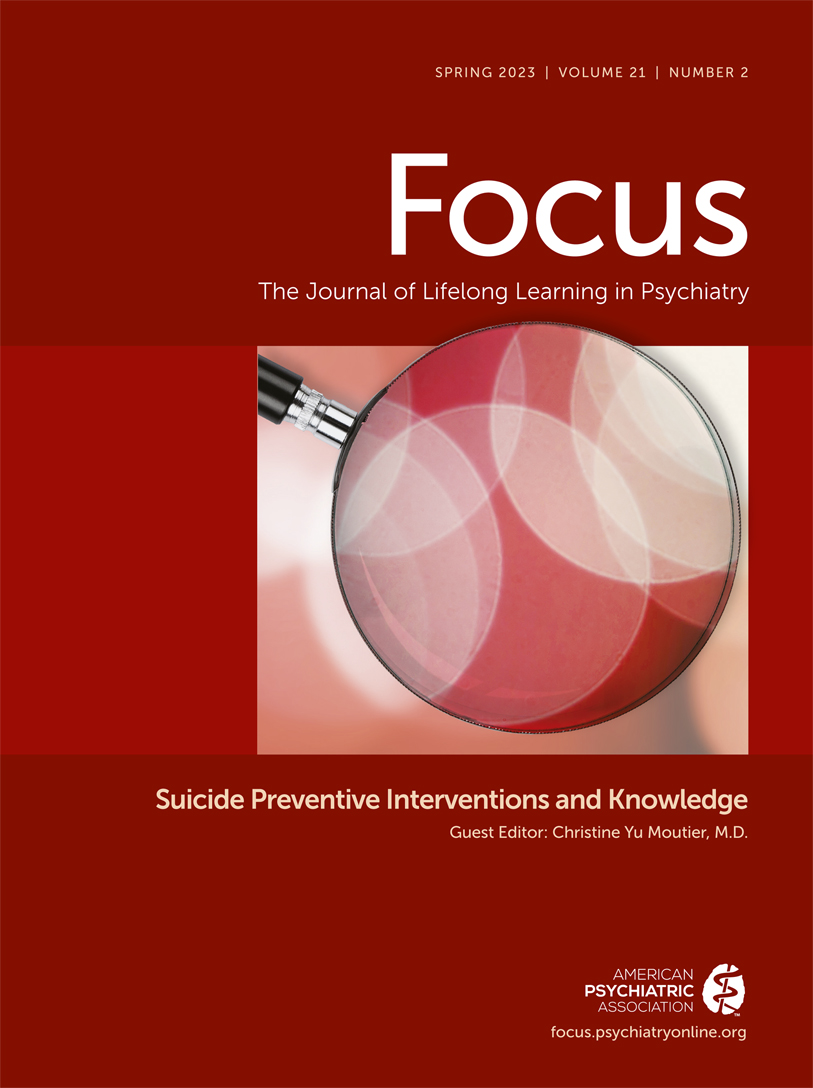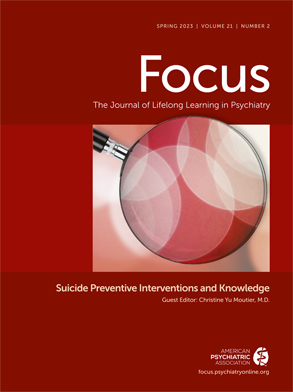Suicide is a long-standing, serious public health threat, but conditions are ripe for a newfound readiness to scale suicide prevention efforts for greater impact. We are seeing advances in the scientific field that are answering key questions about suicide risk and interventions that can reduce risk for specific individuals. As these myth-busting discoveries permeate societal consciousness, the culture surrounding mental health and suicide is changing. Recognition of mental health distress as a common human experience significantly increased during the pandemic (
1), while experiences with family, friends’, and colleagues’ mental health struggles (
2) became more commonplace. This has produced a greater sense of urgency and readiness for actionable strategies that reduce risk. People now understand that suicide is not only a leading cause of death, but also a complex health issue that potentially affects all of us. Recent signs of progress include major national policies and investments in the new, three-digit 988 Suicide and Crisis Lifeline and the engagement of clinical fields and industries outside of mental health, such as the American Academy of Pediatrics (
3), the Occupational Safety and Health Administration’s 2022 declaration (
4), and the construction industry’s priority on suicide prevention (
5).
Perhaps the greatest risk facing the suicide prevention field in this postpandemic era is for momentum to stall, believing that changing
attitudes is sufficient when it is changing
behaviors that is necessary to save lives. Until we take these critical steps toward suicide prevention literacy—turning knowledge into action—we may continue to see the gap widen between positive societal views toward mental health and rising suicide rates. In short, we must begin “walking the talk,” ensuring that national, state, workplace, school, and health system policies align with scientifically informed, risk-reducing actions and workflows (
6). These standards in clinical and community settings must go beyond destigmatizing mental health and help-seeking and move into routine ways of identifying individuals who are becoming at risk in real time, creating a safety net of not only psychological and peer support, but also accessible mental health care for all.
Suicide prevention efforts have not always gotten it right. Graphic or “scared straight” youth campaigns likely increased risk of contagion (
7), and the clinical practice of contracting for safety did more to alleviate clinicians’ anxiety than to provide patients with effective steps to reduce suicide risk (
8). The field has also been humbled by the realization that rising rates of suicide among Black and Hispanic youths and other minoritized populations warrant a prioritized focus on more research and development of programs with treatment specific to key populations, especially when historical traumas and inequities continue to affect every aspect of health—including suicide risk. This is why the field of suicide researchers is so critically important. We cannot afford to waste efforts on ineffective programs or treatment.
In my 10 years as chief medical officer at the American Foundation for Suicide Prevention, we have led private sector funding of suicide prevention research. I have seen the field grow with the integration of priorities on diversity, loss, and lived experience in the design and implementation of new interventions. Do we need more research? Absolutely. Are there still unanswered questions? Most certainly. Relative to other basic science and clinical research fields, the suicide prevention field is still relatively young, and suicide is a profoundly complex phenomenon. There is much work to be done. The key is continuing to invest in suicide research, while also implementing prevention strategies that have been shown to work, including embedding long-term goals and sustainability into the design, because suicide prevention efforts often see gains over years and improvements can be lost when programs or funding end; prioritizing evidence-informed actions and evaluation efforts from the beginning; including diversity, equity, and lived experience experts as part of the team; maintaining a thoughtful and nimble approach, allowing for course correction as needed and when new strategies become available; and integrating a cross-sectoral, population view to scale efforts and reach the greatest number of people who may be at risk.
With these five tenets in mind, suicide prevention efforts are most effective when championed by system leaders and led by an adequately funded, dedicated team employing the combined approach of top-down support and boots-on-the-ground engagement.
Evidence-based interventions effective in reducing suicidal behavior now exist and we must urgently prioritize their implementation. In this special issue of Focus, we have convened top experts to provide guidance in key areas discussed below.
Beginning the issue, Nadine Melhem, Ph.D., David Brent, M.D., and I provide a broad overview of evidence-based suicide prevention strategies, covering epidemiology, pathophysiology, and prevention strategies, in our review, “Implementing Evidence-Based Suicide Prevention Efforts for Greatest Impact.”
Barbara Stanley, Ph.D., a luminary in our field, and two experts provide a superb summary of “Brief and Ultra-Brief Suicide-Specific Interventions.”
In “Pharmacologic Approaches to Suicide Prevention,” Sidney Zisook, M.D., and colleagues offer a thorough review of medications and what we know (and don’t know) about their risk and prevention of suicide.
Lisa Horowitz, Ph.D., M.P.H., and colleagues expertly cover the current evidence and recommendations for screening and suicide risk assessment in their article, “Screening and Assessing Suicide Risk in Medical Settings: Feasible Strategies for Early Detection.”
“Systems Approach to Suicide Prevention: Strengthening Culture, Practice, and Education,” by Anthony Pisani, Ph.D., and Edwin Boudreaux, Ph.D., skillfully explains an essential systems approach for health care settings that includes a case vignette.
John Torous, M.D., M.B.I., and the Harvard Medical School’s Division of Digital Psychiatry, in “Clinical Considerations for Digital Resources in Care for Patients with Suicidal Ideation,” adroitly describe how suicide preventive principles are incorporated in smart phone apps and provide guidance to clinicians on how to select and use apps in clinical care.
Tami Benton, M.D., in this issue’s Ask the Expert feature, adeptly answers the key question: Can you share clinical advice about a culturally informed approach to supporting minoritized patients who may be suicidal?
Thank you for making suicide prevention a priority. This special suicide prevention issue was designed with the busy clinician, educator, and leader in mind. On behalf of the authors and peer reviewers, thank you for considering how you might increase suicide prevention literacy, making advances in your own work to further diminish risk and enhance the protective factors in your patients’, coworkers’, and community members’ lives. Suicide prevention—informed by science, clinicians, lived experience, and a public health framework—can help us bring effective strategies to life, not only in clinical practice, but also throughout the settings where people live, learn, play, worship, and work.

